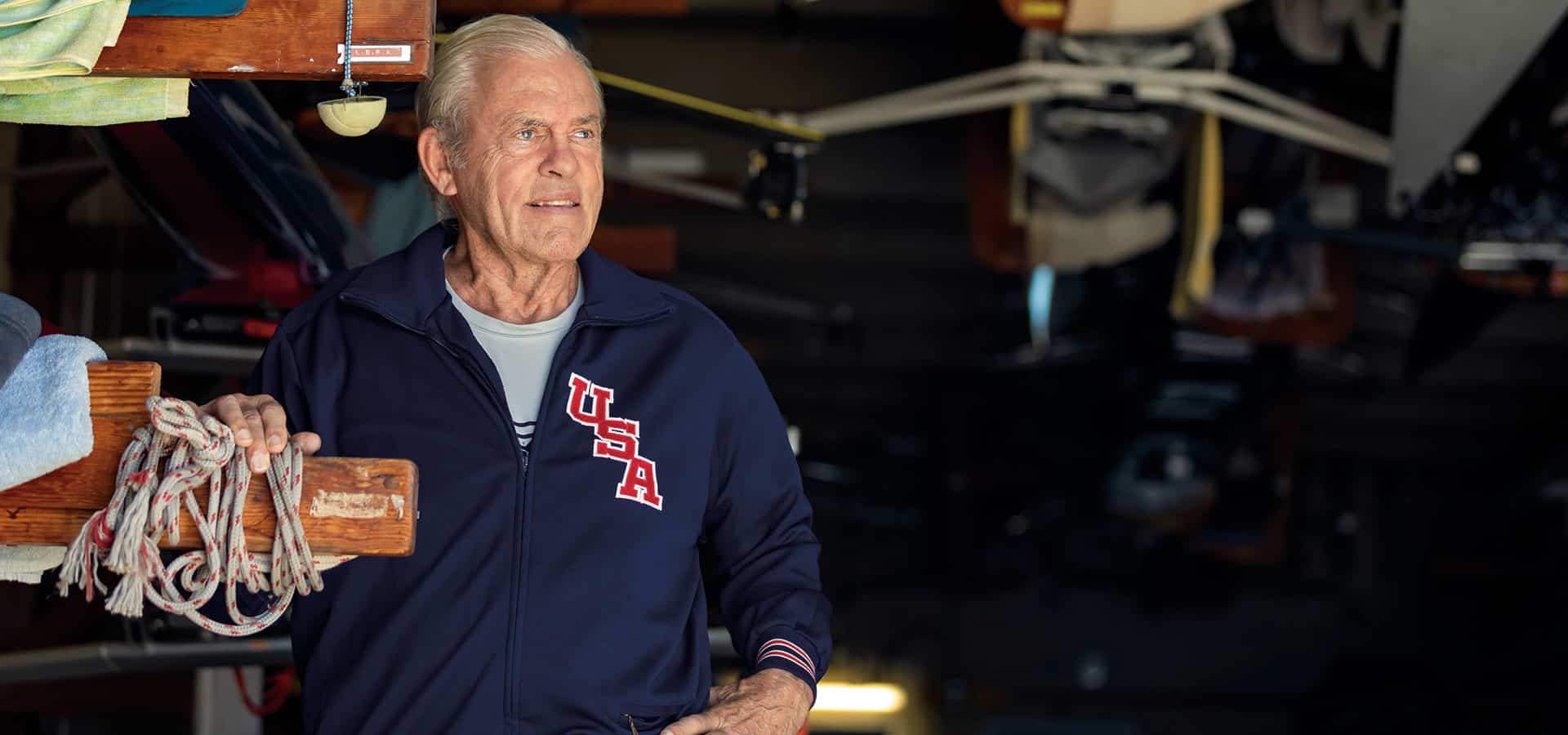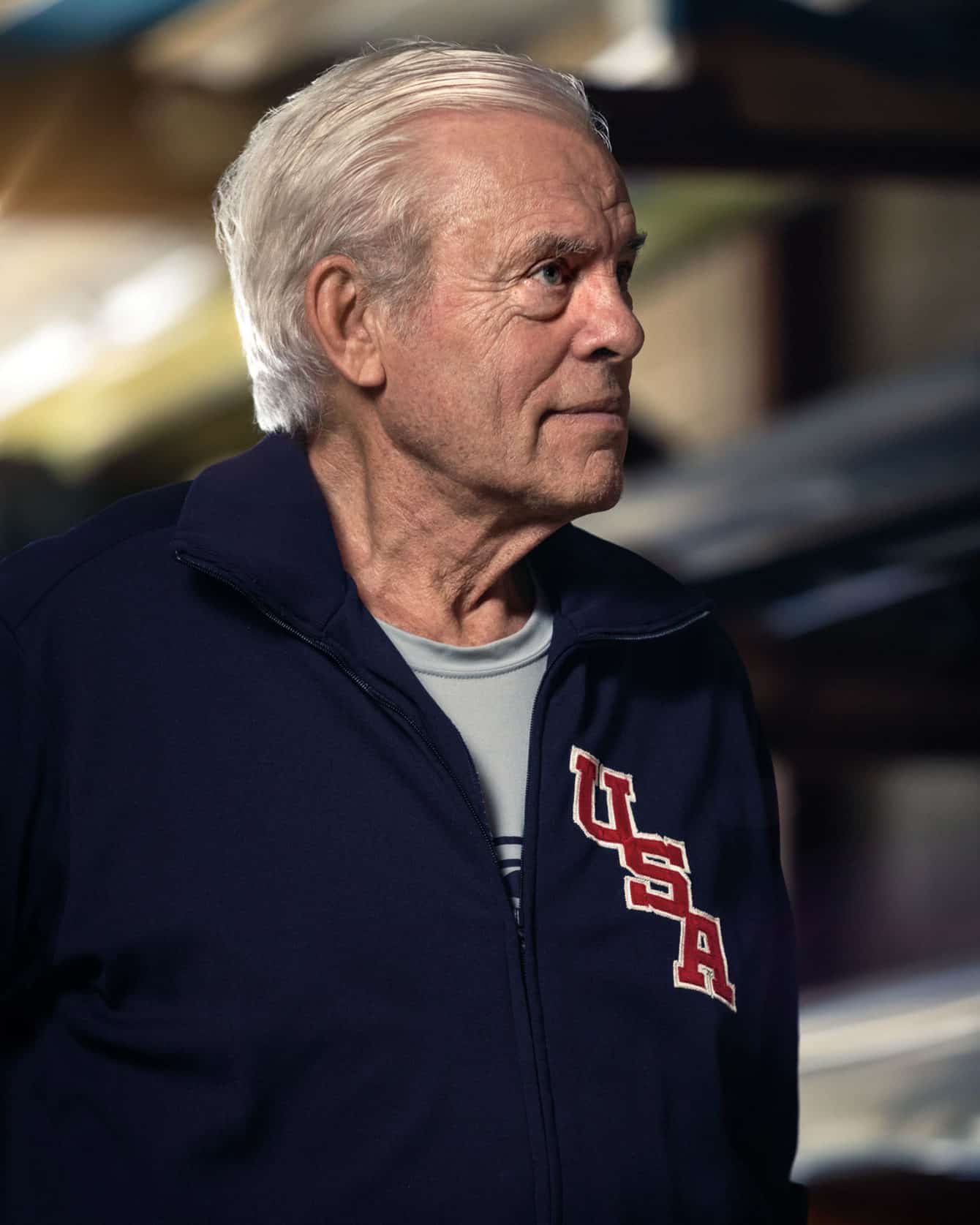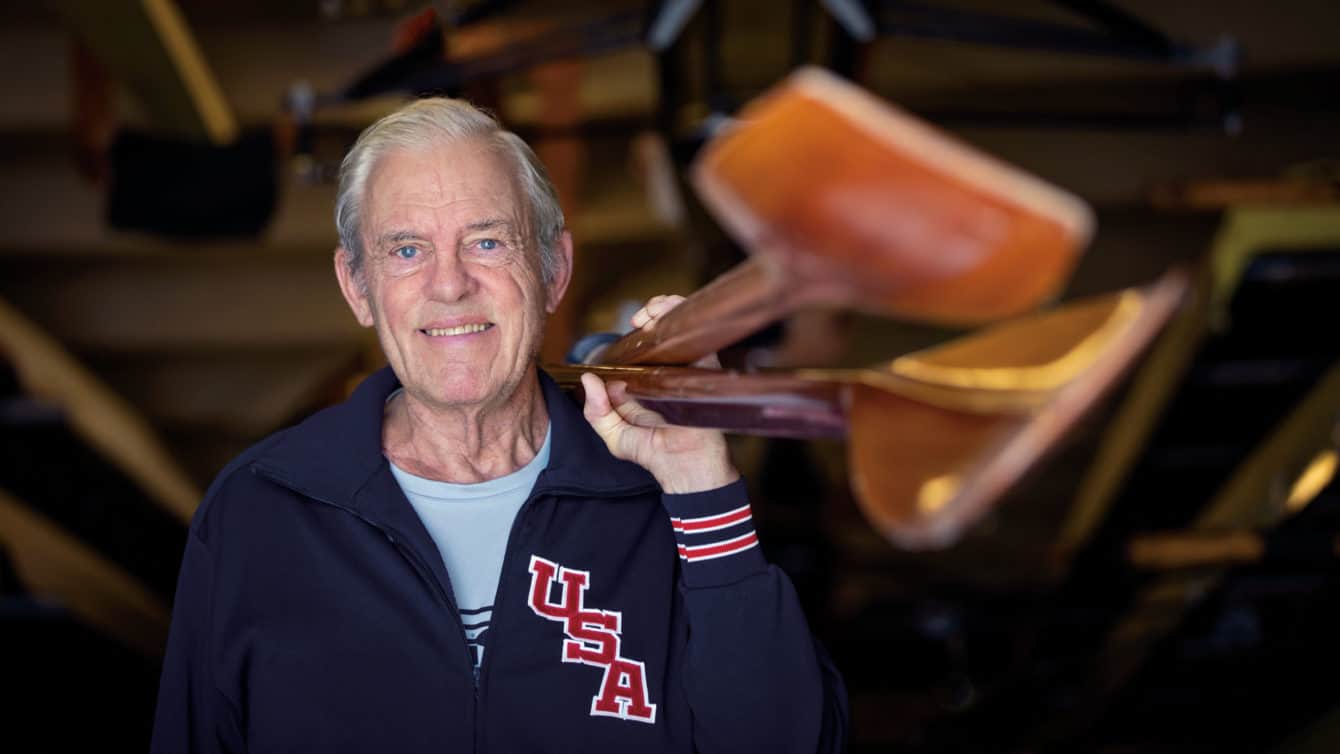
1968 Olympic Games Rower John Nunn Reflects on His Quest for Glory
The SoCal resident took home the bronze 50 years ago.
-
CategoryAdrenaline, Experiences, Makers + Entrepreneurs
-
Written byMichele Garber
-
Photographed byJeff Berting
For nearly six decades John Nunn’s life has been entwined with the esteemed sport of rowing. He has competed and coached at the collegiate and international level while serving as mentor and advocate for others in his sport. He and his wife, Maureen, have been happily married and living in her Rolling Hills childhood home for almost 50 years, where they raised their five children—now adults.
After success in the corporate world John became an entrepreneur, launching his own manufacturer’s rep business. John has led a full and fascinating life. Yet much of his remarkable life may have unfolded quite differently had it not been for a fateful, life-altering moment in 1960 on his very first day at Cornell University.
Most of us can reflect back on our lives and distinguish those key moments, chance encounters or critical choices we made that inexorably set the course of our destiny. For John Nunn, that pivotal moment came while waiting at freshman registration at Cornell.
A tall, strapping, athletic young man, John had played many sports growing up including basketball, cricket and ice hockey. But his plan was to play football at Cornell. John’s father had played football for Cornell and had gone on to play professional ball with the Boston Shamrocks in the original American Football League of the 1930s. That fateful day at freshman registration, John’s path to follow in his father’s cleated footsteps seemed certain. Queue fate.
While standing in the registration line he was approached by Bill Stowe, captain of the prior year’s champion freshman rowing team. Since height is an essential attribute of rowers, John’s towering build easily caught Bill’s attention among the hundreds of freshmen milling about in the auditorium.
Bill approached John and asked if he had any interest in rowing. Resolute in his gridiron intentions, John politely declined—saying he planned to play football. But Cornell had one of the most preeminent rowing programs in the country, and Bill was looking to enhance their crew—so he wasn’t easily dissuaded. He told John that Cornell had a top rowing team and added that the year John would graduate would be an Olympic year. Thus if he became a competitive rower, he could potentially have Olympic prospects. John’s curiosity was piqued.
Bill plucked John from the line and brought him to meet rowing coach Walt Schlaepfer. The life-changing conversation went something like this: Coach Schlaepfer: “How tall are you, and what do you weigh?” John: “6’6” and 197 lbs.” Coach: “Perfect! Got any experience rowing?” John: “None.” Coach: “That’s the way we like ’em.”
In an instant John’s football plans evaporated, and he began rowing the next day. Fortunately rowing is not a sport that requires athletes to start at a young age to succeed. With his raw athletic talent, John took naturally to rowing and, more importantly, he loved it. His natural ability and work ethic led to quick success in the water.
His freshman team placed second in the National Championships. His sophomore and junior teams went undefeated and were Varsity Eight National Collegiate Champions in 1962 and 1963. Their crew was even featured on the cover of Sports Illustrated. John’s team placed second in the Grand Challenge Finals at the prestigious Henley Royal Regatta in London and took third place in the Varsity Eight in 1964.
John twice competed for a spot on the 1964 Olympic team—first on an eight-man sweep team that was sadly eliminated by Yale. Then a few weeks later John rowed with a four-man team whose chance to qualify for an Olympic berth looked strong until one of the teammates injured his back a week before trials and they had to scratch. Meanwhile John’s former Cornell friend and teammate, Bill Stowe, captained a scull team that went on to win gold in the 1964 Tokyo Games.
Inspired by his teammate’s success and still only 22 years old, John wanted another shot at competing in an Olympic Games and decided to continue rowing in hopes of making the 1968 Mexico City team. He also opted to switch from sweep (two hands on one oar) to scull (one oar in each hand).
After graduating from Cornell in 1964, John entered grad school at the University of Michigan and received his MBA in 1966. Throughout his time at Michigan, John continued rowing.
Fortunately the mid-‘60s job market was red-hot, and John received multiple offers from companies throughout the U.S.—he had his pick of where to relocate. Notable among the offers was a position with Pillsbury as brand manager for a new product line: the Pillsbury Doughboy.
John recounts that the Pillsbury position was hands-down the best job offer he received. There was just one catch: Pillsbury was based in Minneapolis, where the ground and water are frozen six months of the year—or as John amusingly refers to it, “a hard water problem.” To adequately train for the Olympics, John needed a climate conducive to year-round rowing. Intent on pursuing his Olympic dream, John instead accepted a position in Beverly Hills with Dart Industries—a multi-billion-dollar conglomerate in the drug, chemical and plastics industry.
Looking back on the decision, John laughs at how he may have become a “Dough Boy” himself eating the samples. More importantly he would never have met his wife or been in the Olympics had he taken the Pillsbury job.

Beyond Southern California’s ideal weather that would allow year-round training, there was an additional benefit to moving to L.A. After Los Angeles hosted the 1932 Olympic Games, many of the world-class venues used in the Games remained in place. Among those was a top-notch rowing facility, boat house and rowing club in Long Beach. By relocating to L.A., John would have the unique opportunity to train at an actual Olympic venue.
John was working 10+-hour days at Dart—requisite for a newly minted marketing exec. All of his free time was spent training and commuting across the L.A. Basin. John found it hard to even find time for sleep.
Then another life-changing event occurred: On a blind date he met Rolling Hills native Maureen Drown, a beautiful and spirited redhead. John was smitten. Though the two hit it off instantly, courting Maureen proved complicated given John’s 24/7 work and training schedule. And the local beauty had other potential suitors.
As John recounts, “I would call her up every Tuesday night. I would pop my Stouffer’s TV dinner in the oven (microwaves didn’t exist), set the timer for 20 minutes and call Maureen. The timer would ding, and I’d say, ‘Sorry, I’ve got to go.’ And that was all the contact we had. She must have thought the timer was someone ringing the doorbell.”
John laughingly recounts, “She was so impressed with that intense level of courtship that she got engaged to somebody else.”
Meanwhile John’s ambition to compete in the 1968 Olympics endured. In 1967 Dart gave him an unpaid leave of absence, and he traveled to New York, Canada and Europe for about four months to qualify for and compete in the Pan Am Games. John rowed in the double sculls at the European Championships in Vichy, France, placing sixth. He earned the silver medal in single scull at the Pan Am Games in Winnipeg, Canada.
Upon his return from the Pan Am Games, fortune shined on John once again. Maureen had split with her fiancé. John and Maureen were reunited, and shortly thereafter they got engaged.
Fresh off his success in Winnipeg, John was primed to try once again to qualify for the Olympic team—and he had luck on his side. The qualifiers for the 1968 team were held in Long Beach—John’s backyard.
Alas, the day of his trial for single scull he had the stomach flu and didn’t secure a spot. Luckily rowing tryouts were wisely separated so single and eights would compete first, then doubles and fours would compete six weeks later—giving those who missed the team for singles and eights a second chance.
John partnered with Bill Maher, a fellow rowing teammate, competitor and friend. John and Bill instantly clicked, won their trial and made the U.S. team. Before long they were off to Gunnison, Colorado, for high-altitude training in preparation for the Mexico City Games.
Although the 1968 Mexico City Olympic Games are sometimes overshadowed in comparison to higher profile Olympic Games like those of 1972 and 1976, the 1968 Games certainly had historical significance … and even controversy. The most notable aspect of the 1968 Games was the high altitude and its impact on competition. Many Olympic records fell because the thinner air allowed people and objects to pass more quickly through air. The javelin, discus, even high and long jumpers were positively impacted.
On the flip side, the altitude had a much more significant and adverse effect on endurance sports. Only a small number of athletes hailing from high-altitude locales were able to compete at their peak performance. Many top athletes fell short of their goals and records as the effects of altitude diminished their capabilities. The impact was so pronounced, the International Olympic Committee (IOC) will never again award a Summer Games to a high-altitude city.
John recalls seeing as many as 30 rowers pass out during practice and competition. And in the case of rowing, this was especially dangerous because the rowers would plop unconscious right into the water.
In preparation for the altitude of Mexico City, Bill and John trained at high altitude in Colorado. But adapting to altitude can take many months, and Gunnison has an extremely dry climate. The dry air caused respiratory issues for many athletes including Bill, who developed persistent bronchitis. He muscled through all of his qualifying heats and managed to row well enough that the pair received the bronze medal in the finals.
But after every row, Bill passed out. As John recounts, “When we finished our race, Bill was passed out on the dock, so John Van Blum, the single scull, had to jump in and accept Bill’s medal.” After the competition, Bill went out and had several tequilas, which miraculously cured his bronchitis. If only he’d had tequila a few days earlier.
The other major news story of the 1968 Olympics was the Black Power movement that professor and civil rights activist Dr. Harry Edwards pushed during the Games. Dr. Edwards unsuccessfully tried to get the entire U.S. Olympic team to boycott the Games.
Though the boycott failed, two of Edwards’ students from San Jose State—Tommie Smith and John Carlos, who won gold and bronze in the 200-meter sprint respectively—created an international uproar with a high-profile protest during their medal ceremony. While the U.S. National Anthem was playing, Tommie and John mounted the podium in black socks sans shoes to symbolize poverty, and each raised a black-gloved fist into the air—the symbol of Black Power.
After the ceremony they were booed, publicly ridiculed, suspended by the U.S. Olympic team and expelled from the Olympic Village by the IOC. Five decades later, as our nation once again grapples with similar issues, they are now widely recognized as heroes of the 1960s civil rights movement.
At the time, John’s perception of the protest was in keeping with most of the U.S. and other athletic delegations competing at the 1968 Games. Most acknowledged the pair’s right to protest yet preferred that the Games remain apolitical.

Just 10 days before the Opening Ceremony of the 1968 Games, Mexican police and military troops massacred dozens of unarmed students during a protest in the Tlatelolco district of Mexico City. The massacre was followed with a vast government coverup, many details of which are only coming to light now—50 years later.
At the time the Mexican government downplayed the severity of the incident, so international awareness was minimized. As John recalls, during the Games he and his teammates were essentially unaware that any recent unrest had occurred. It was only after they returned home that they learned of the tragic event.
After Mexico City, John returned to California, married Maureen and started a family. In 1971 he again competed in the Pan Am Games in Cali, Columbia, and won the bronze in double sculls. He considered trying to compete in the 1972 Munich Games, but he had a rapidly growing family to support. His employer at the time, Martin Marietta, would not give him the time off, so he opted not to pursue another Olympic run. Yet John’s passion for the sport remained high, and he continued rowing.
In 1976 the IOC added women’s rowing as an official Olympic sport. Over the years John had met several of the women’s team members who also trained in Long Beach. He’d often chat with them and occasionally give them pointers. When their coach pulled out due to illness, they invited John to be their coach in Montreal. It was at the 1976 Games that John had one his most enduring and memorable Olympic experiences.
Certainly winning the bronze in 1968 was the high point of John’s Olympic journey. But perhaps a close second occurred while John was in Montreal with the women’s team. Between races, John enjoyed spending his free time in the athlete’s village. At both the Mexico City and Montreal Games, John became an avid Olympic swag trader.
One day while at the village trading, he ran into a Romanian rower named Walter Lambertus whom he’d previously met while riding the shuttle to the rowing venue. Walter was fluent in English, and the two had had an enjoyable chat while on the bus.
Walter approached John in the village with an unusual request. He was planning to defect to Canada, where unbeknownst to Romanian authorities his uncle lived. He asked John to help him get his belongings out of the heavily guarded Romanian dorm and hold them in his room until he was ready to defect.
Romanian President Nicolae Ceauşescu was a notoriously brutal dictator who had mistreated his people since assuming power a decade earlier. John was more than happy to oblige his new friend in his effort to escape Communist Romania.
They hatched a plan. John would bring his swag bag, and when they’d arrive at the Romanian dorm they’d pretend to be trading items while actually retrieving Walter’s belongings. Feeling a slight tinge of nervous energy, the two entered the dorm room and there was a group of 16 other Romanians glued to the television. At that exact moment Nadia Comăneci was on the balance beam, and the Romanians were mesmerized.
The diversion gave them a perfect opportunity. John said to Walter, “Let’s not screw around. Let’s get your stuff and get the hell out of here.” The next day Walter successfully defected. Three more Romanians and a Russian also defected to Canada during the 1976 Games.
For the crime of defecting, Walter was sentenced in absentia to 20 years of hard labor. He moved to the Niagara Falls area and for many years lived in fear of being caught by Romanian secret police. He ceased direct contact with Romania and forwarded letters to a friend in Austria who would repackage and mail them home for him. He had triple locks on his doors and a rope ladder ready to go out a window if he was ever found.
After the fall of Ceauşescu, Walter was finally able to relax. He now has a family and lives in the Whistler area. John and Walter have remained good friends. A few years ago they met up in B.C. and shared a bottle of Romanian brandy that Walter had given John in Montreal.
After coaching the 1976 women’s team, John returned home and continued to row while also broadening his involvement in other aspects of the sport. He has served in leadership positions and on the boards of multiple rowing organizations including serving as president of both the Southern California Rowing Foundation and the Long Beach Rowing Association.
In 2008 John was inducted into the Cornell Athletic Hall of Fame. At 76, John still runs his manufacturing rep business. He and Maureen now have five grandchildren. And he continues to row regularly. He recently had knee surgery but looks forward to getting his scull back in the water soon.
This Oakland-Based Artist Upholds the Tradition of Stained-Glass Design
Theodore Ellison brings century-old techniques to a contemporary vision.
Robert Rauschenberg’s Ambitious 17-Year, Quarter-Mile Project Arrives at LACMA
The massive installation and the artist’s L.A. connection highlight the exhibition.


















